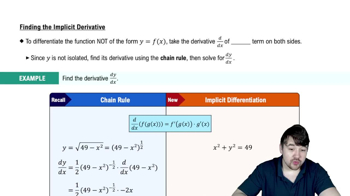Table of contents
- 0. Functions7h 52m
- Introduction to Functions16m
- Piecewise Functions10m
- Properties of Functions9m
- Common Functions1h 8m
- Transformations5m
- Combining Functions27m
- Exponent rules32m
- Exponential Functions28m
- Logarithmic Functions24m
- Properties of Logarithms34m
- Exponential & Logarithmic Equations35m
- Introduction to Trigonometric Functions38m
- Graphs of Trigonometric Functions44m
- Trigonometric Identities47m
- Inverse Trigonometric Functions48m
- 1. Limits and Continuity2h 2m
- 2. Intro to Derivatives1h 33m
- 3. Techniques of Differentiation3h 18m
- 4. Applications of Derivatives2h 38m
- 5. Graphical Applications of Derivatives6h 2m
- 6. Derivatives of Inverse, Exponential, & Logarithmic Functions2h 37m
- 7. Antiderivatives & Indefinite Integrals1h 26m
- 8. Definite Integrals4h 44m
- 9. Graphical Applications of Integrals2h 27m
- 10. Physics Applications of Integrals 2h 22m
3. Techniques of Differentiation
Derivatives of Trig Functions
Problem 3.R.39
Textbook Question
9–61. Evaluate and simplify y'.
y=sin √cos² x+1
 Verified step by step guidance
Verified step by step guidance1
First, identify the given function: \( y = \sin(\sqrt{\cos^2 x + 1}) \). We need to find the derivative \( y' \).
Recognize that this is a composition of functions, so we will use the chain rule. The outer function is \( \sin(u) \) where \( u = \sqrt{\cos^2 x + 1} \).
Differentiate the outer function \( \sin(u) \) with respect to \( u \), which gives \( \cos(u) \).
Next, differentiate the inner function \( u = \sqrt{\cos^2 x + 1} \) with respect to \( x \). This requires using the chain rule again: first differentiate \( \sqrt{v} \) where \( v = \cos^2 x + 1 \), giving \( \frac{1}{2\sqrt{v}} \).
Finally, differentiate \( v = \cos^2 x + 1 \) with respect to \( x \). This involves using the chain rule on \( \cos^2 x \), which gives \( -2\cos(x)\sin(x) \). Combine all these derivatives using the chain rule to find \( y' \).
 Verified video answer for a similar problem:
Verified video answer for a similar problem:This video solution was recommended by our tutors as helpful for the problem above
Video duration:
6mPlay a video:
Was this helpful?
Key Concepts
Here are the essential concepts you must grasp in order to answer the question correctly.
Chain Rule
The Chain Rule is a fundamental differentiation technique used to differentiate composite functions. It states that if a function y is composed of another function u, then the derivative of y with respect to x can be found by multiplying the derivative of y with respect to u by the derivative of u with respect to x. This is essential for evaluating derivatives of functions like y = sin(√(cos²(x) + 1), where multiple layers of functions are involved.
Recommended video:

Intro to the Chain Rule
Trigonometric Derivatives
Trigonometric derivatives refer to the derivatives of trigonometric functions such as sine, cosine, and tangent. For instance, the derivative of sin(u) is cos(u) multiplied by the derivative of u. Understanding these derivatives is crucial for simplifying expressions involving trigonometric functions, especially when applying the Chain Rule in the given problem.
Recommended video:

Derivatives of Other Inverse Trigonometric Functions
Implicit Differentiation
Implicit differentiation is a technique used to differentiate equations where y is not explicitly solved for x. It allows us to find the derivative of y with respect to x by treating y as a function of x, even if y is defined implicitly. This concept is useful when dealing with complex functions, such as the one in the question, where direct differentiation may not be straightforward.
Recommended video:

Finding The Implicit Derivative

 3:53m
3:53mWatch next
Master Derivatives of Sine & Cosine with a bite sized video explanation from Callie
Start learning




